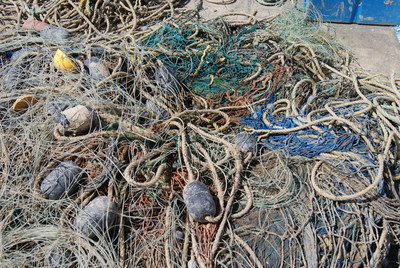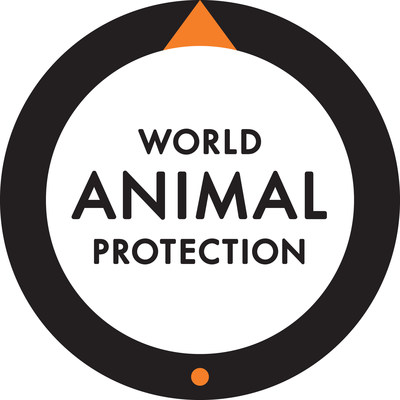World Animal Protection, CIRVA, and Monterey Bay Diving join forces to protect the critically endangered vaquita porpoise, the world's most endangered marine mammal
SAN FELIPE, Mexico, June 30, 2017 /PRNewswire-USNewswire/ -- World Animal Protection, the International Committee for the Recovery of the Vaquita (CIRVA), and Monterey Bay Diving joined forces with local fishermen in San Felipe, Mexico this spring to locate illegal gillnets in critical vaquita porpoise habitat in the Gulf of California. The team used unique sonar scanning technology to locate illegal and discarded fishing nets likely to cause entanglement of the vaquita species and ultimately removed approximately 5,702 square meters of net. The gillnets recovered will be recycled by partners in the Global Ghost Gear Initiative founded by World Animal Protection, for use as nylon-based products.

The vaquita is the most endangered marine mammal on the planet with only an estimated 25 remaining animals left, all of them living in the Gulf of California. The vaquita's proximity to extinction is due to illegal fishing activity and the resulting abandoned gillnets, known as ghost nets. Nylon gillnets intended to catch a fish called the totoaba, a critically endangered species sold illegally in China where its swim bladder is prized for use in traditional medicine, entangle and drown the vaquita. As the illegal totoaba fishery ends for the season once the fish stock has migrated, the abandoned nets left in the shared habitat frequently snare and kill vaquitas.
"Ghost nets resulting from illegal fishing are the biggest contributors to the decline of the vaquita population," said Elizabeth Hogan, U.S. Oceans and Wildlife Campaign Manager at World Animal Protection. "We are so pleased to be able to connect the innovative sonar scanning technology of Monterey Bay Diving with the on-the-ground gear removal initiatives of CIRVA to remove deadly ghost nets from the water and gather crucial data that can make a life-saving difference for this critically endangered animal."
World Animal Protection, CIRVA, and Monterey Bay Diving teamed up to locate gillnets via a unique application of sonar technology, provided by Monterey Bay Diving, which uses multiple acoustic signals positioned at an oblique angle to the sea floor that gives a broad digital image of the area. During its mission in the Gulf of California this May, the team could view a span of up to 200 meters, due to depth and sea floor composition. Monterey Bay Diving operates a dual-frequency model of sonar scanner allowing for high (1600 kH) and low (600 kH) frequency sonar. The team's sonar capacity made it possible to determine the location of nets in the habitat area for removal, using pangas and grappling along a transect system to locate and mark fishing nets.
The scanned images of the illegal ghost nets that the team located in the vaquita habitat revealed valuable insight into the methodologies used by those fishing illegally and will inform ongoing net recovery efforts by Museo de la Ballena and Sea Shepherd Conservation Society. Under the coordination of SEMARNAT and with the assistance of the Mexican navy, all of these groups worked together with local fishermen to locate and remove the illegal gillnets in an international effort to protect the few remaining vaquita porpoises and hopefully prevent the extinction of the species. The data and lessons learned from the sonar scanning conducted by Monterey Bay Diving and CIRVA is being shared with local and global NGOs and the Mexican government to make use of these findings to protect the vaquita.
"Monterey Bay Diving was pleased to provide our advanced sonar imaging technology to help locate and remove illegal totoaba gillnets and provide forensic data from the sea floor in the Northern portion of the Gulf of California, in an effort to help save the vaquita population," says Jared Berg, President of Monterey Bay Diving. "Monterey Bay Diving is proud to be a part of this project and maintains a strong advocacy of the ocean and its marine life."
World Animal Protection is working to reduce the suffering caused by ghost gear through its Sea Change campaign. A staggering 640,000 tons of ghost fishing gear is left in our oceans each year, killing approximately 136,000 seals, sea lions, and whales, every year, in addition to millions of birds, turtles, and fish. World Animal Protection's Sea Change campaign works to reduce the volume of ghost gear, remove and recycle such gear, and rescue entangled animals.
- For more information, including photos, sonar scanning images, and interviews, please contact Carla Pisarro, +1-646-783-2210, [email protected]
About World Animal Protection
World Animal Protection is active in more than 50 countries. From our offices around the world, we work with businesses, governments, local partners and animal welfare organizations. We help people to find practical ways to prevent animal suffering worldwide. We collaborate with national governments, and we have formal relationships with international bodies including the Food and Agriculture Organization of the United Nations, the United Nations Environment Programme, the Council of Europe and the World Organisation for Animal Health (OIE). We seek national and international policy change to improve the lives of millions of animals, because animal protection is a fundamental part of a sustainable future.
For more information on World Animal Protection's work to protect vaquitas, visit https://www.worldanimalprotection.us.org/vaquita-most-endangered-marine-mammal
About CIRVA
The International Committee for the Recovery of the Vaquita (CIRVA) was established in 1996 by the Mexican Ministry of Environment, Natural Resources and Fisheries. CIRVA's primary goal is to develop a recovery plan for the species based on the best scientific evidence. The creation of CIRVA was a critical step towards vaquita conservation.
CIRVA's work on this project was generously funded by the Association of Zoos and Aquariums (AZA).

SOURCE World Animal Protection
News published on and distributed by:



